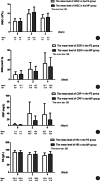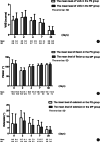Comparison of Postoperative Effects between Medial Pivot Prosthesis and Posterior Stabilized Prosthesis
- PMID: 33094903
- PMCID: PMC7767686
- DOI: 10.1111/os.12822
Comparison of Postoperative Effects between Medial Pivot Prosthesis and Posterior Stabilized Prosthesis
Abstract
Objective: To compare the postoperative inflammation and pain response between medial pivot (MP) and posterior stabilized (PS) prostheses among total knee arthroplasty (TKA) patients.
Methods: A prospective cohort study was conducted from January 2019 to May 2019 at the Affiliated Hospital of Qingdao University. The study included patients diagnosed with stage III or IV Kellgren-Lawrence knee osteoarthritis (KOA) who had failed conservative treatment, had undergone no previous knee surgeries, had varus substantial deformities (11°-20° deviation), and had received their first unilateral TKA. A total of 109 patients who underwent PS prosthesis TKA and 98 patients who underwent MP prosthesis TKA were continuously enrolled. Inflammation biomarkers, such as leukocyte (white blood cells), erythrocyte sedimentation rate (ESR), and C-reactive protein (CRP), together with hemoglobin (Hb), the visual analog pain score (VAS) and range of motion (ROM) were compared between the two groups. The Student t-test was applied to analyze continuous parameters, and the χ2 -test was used for categorical parameters. The linear mixed model was used for the repeated measurement data from the follow-up visits. Multivariate backward logistic and linear regression models were used to determine the factors potentially influencing prostheses and VAS scores.
Results: All these enrolled patients were followed up at 2, 4, 7, and 30 days after TKA. There were no significant differences between the PS group and the MP group in body mass index (BMI), gender, laterality, usage of nonsteroidal anti-inflammatory drugs (NSAIDs) and opioids, and drain tube extubation time (P > 0.05). Compared with the PS group, the MP group were older (67.5 years vs 65.4 years), and had a higher mid-vastus approach rate (67.3% vs 26.6%), a shorter tourniquet duration (68.3 ± 10.2 h vs 73.9 ± 11.2 h), a larger prosthetic pad (10.8 ± 1.2 mm vs 10.4 ± 1.2 mm), and a lower drain tube diversion volume (187.6 ± 119.3 mL vs 234.0 ± 155.7 mL). In the linear mixed model, MP prostheses had less CRP and ESR elevation and less Hb decrease than PS prostheses (P for group × time < 0.001). There were no significant differences in the changing trends between MP and PS prostheses by time for VAS scores and ROM. In the multivariate logistic regression model, MP prostheses showed significant differences compared with PS prostheses in treatment approach (odds ratio [OR] = 3.371, 95% confidence interval [CI]: 1.953-7.127; P < 0.001), ultrasound treatment start time (OR = 2.669, 95% CI: 1.385-5.141; P = 0.003), and tourniquet duration (OR = 0.954, 95% CI: 0.925-0.984; P = 0.003). Higher VAS scores on the second day postoperatively were related to high VAS scores preoperatively, use of opioids, high drain tube diversion, long tourniquet duration, and long drain tube extubation (P < 0.05), respectively.
Conclusion: The MP prostheses showed potential advantages compared with PS prostheses in TKA in inflammatory responses.
Keywords: Inflammation; Medial pivot prostheses; Posterior stabilized prostheses; Postoperative effects; Total knee arthroplasty.
© 2020 The Authors. Orthopaedic Surgery published by Chinese Orthopaedic Association and John Wiley & Sons Australia, Ltd.
Figures





Similar articles
-
Medial pivot prosthesis has a better functional score and lower complication rate than posterior-stabilized prosthesis: a systematic review and meta-analysis.J Orthop Surg Res. 2022 Aug 19;17(1):395. doi: 10.1186/s13018-022-03285-0. J Orthop Surg Res. 2022. PMID: 35986362 Free PMC article.
-
Early Patellofemoral Function of Medial Pivot Prostheses Compared with Posterior-Stabilized Prostheses for Unilateral Total Knee Arthroplasty.Orthop Surg. 2021 Apr;13(2):417-425. doi: 10.1111/os.12895. Epub 2021 Jan 5. Orthop Surg. 2021. PMID: 33403815 Free PMC article.
-
A Retrospective Comparison of a Medial Pivot and Posterior-Stabilized Total Knee Arthroplasty With Respect to Patient-Reported and Radiographic Outcomes.J Arthroplasty. 2018 May;33(5):1379-1383. doi: 10.1016/j.arth.2017.11.049. Epub 2017 Dec 7. J Arthroplasty. 2018. PMID: 29276117
-
Comparison of Patient Satisfaction Between Medial Pivot Prostheses and Posterior-Stabilized Prostheses in Total Knee Arthroplasty.Orthop Surg. 2020 Jun;12(3):836-842. doi: 10.1111/os.12687. Epub 2020 May 10. Orthop Surg. 2020. PMID: 32390346 Free PMC article.
-
Comparison of clinical and radiographic results between total knee arthroplasties using medial pivot and posterior-stabilized prosthesis: A meta-analysis.Medicine (Baltimore). 2021 Jan 29;100(4):e23809. doi: 10.1097/MD.0000000000023809. Medicine (Baltimore). 2021. PMID: 33530177 Free PMC article.
Cited by
-
Medial Pivot Versus Posterior-Stabilized Prosthesis Design in Primary Total Knee Arthroplasty: A Systematic Review and Meta-Analysis.Indian J Orthop. 2022 Jul 11;56(9):1506-1524. doi: 10.1007/s43465-022-00678-5. eCollection 2022 Sep. Indian J Orthop. 2022. PMID: 36052392 Free PMC article. Review.
-
Medial pivot prosthesis has a better functional score and lower complication rate than posterior-stabilized prosthesis: a systematic review and meta-analysis.J Orthop Surg Res. 2022 Aug 19;17(1):395. doi: 10.1186/s13018-022-03285-0. J Orthop Surg Res. 2022. PMID: 35986362 Free PMC article.
-
Larger Medial Contact Area and More Anterior Contact Position in Medial-Pivot than Posterior-Stabilized Total Knee Arthroplasty during In-Vivo Lunge Activity.Bioengineering (Basel). 2023 Feb 23;10(3):290. doi: 10.3390/bioengineering10030290. Bioengineering (Basel). 2023. PMID: 36978681 Free PMC article.
References
-
- Tang X, Wang S, Zhan S, et al The prevalence of symptomatic knee osteoarthritis in China: results from the China health and retirement longitudinal study. Arthritis Rheumatol, 2016, 68: 648–653. - PubMed
-
- Bontempi M, Roberti di Sarsina T, Marcheggiani Muccioli GM, et al J‐curve design total knee arthroplasty: the posterior stabilized shows wider medial pivot compared to the cruciate retaining during chair raising. Knee Surg Sports Traumatol Arthrosc, 2020, 28: 2883–2892. - PubMed
-
- Dorr LD, Ochsner JL, Gronley J, Perry J. Functional comparison of posterior cruciate‐retained versus cruciate‐sacrificed total knee arthroplasty. Clin Orthop Relat Res, 1988, 236: 36–43. - PubMed
-
- Ranawat CS, Komistek RD, Rodriguez JA, Dennis DA, Anderle M. In vivo kinematics for fixed and mobile‐bearing posterior stabilized knee prostheses. Clin Orthop Relat Res, 2004, 418: 184–190. - PubMed
Publication types
MeSH terms
Substances
Grants and funding
LinkOut - more resources
Full Text Sources
Medical
Research Materials
Miscellaneous

